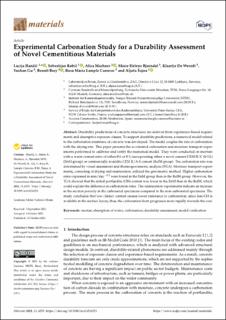| dc.contributor.author | Hanžič, Lucija | |
| dc.contributor.author | Robič, Sebastijan | |
| dc.contributor.author | Machner, Alisa | |
| dc.contributor.author | Bjørndal, Marie Helene | |
| dc.contributor.author | De Weerdt, Klaartje | |
| dc.contributor.author | Gu, Yushan | |
| dc.contributor.author | Bary, Benoît | |
| dc.contributor.author | Carreras, Rosa Maria Lample | |
| dc.contributor.author | Šajna, Aljoša | |
| dc.date.accessioned | 2022-04-04T09:10:40Z | |
| dc.date.available | 2022-04-04T09:10:40Z | |
| dc.date.created | 2021-12-06T19:30:55Z | |
| dc.date.issued | 2021 | |
| dc.identifier.citation | Materials. 2021, 14 (21), . | en_US |
| dc.identifier.issn | 1996-1944 | |
| dc.identifier.uri | https://hdl.handle.net/11250/2989465 | |
| dc.description.abstract | Durability predictions of concrete structures are derived from experience-based requirements and descriptive exposure classes. To support durability predictions, a numerical model related to the carbonation resistance of concrete was developed. The model couples the rate of carbonation with the drying rate. This paper presents the accelerated carbonation and moisture transport experiments performed to calibrate and verify the numerical model. They were conducted on mortars with a water-cement ratio of either 0.6 or 0.5, incorporating either a novel cement CEM II/C (S-LL) (EnM group) or commercially available CEM II/A-S cement (RefM group). The carbonation rate was determined by visual assessment and thermogravimetric analysis (TGA). Moisture transport experiments, consisting of drying and resaturation, utilized the gravimetric method. Higher carbonation rates expressed in mm/day−0.5 were found in the EnM group than in the RefM group. However, the TGA showed that the initial portlandite (CH) content was lower in the EnM than in the RefM, which could explain the difference in carbonation rates. The resaturation experiments indicate an increase in the suction porosity in the carbonated specimens compared to the non-carbonated specimens. The study concludes that low clinker content causes lower resistance to carbonation, since less CH is available in the surface layers; thus, the carbonation front progresses more rapidly towards the core. | en_US |
| dc.language.iso | eng | en_US |
| dc.publisher | MDPI | en_US |
| dc.rights | Navngivelse 4.0 Internasjonal | * |
| dc.rights.uri | http://creativecommons.org/licenses/by/4.0/deed.no | * |
| dc.title | Experimental carbonation study for a durability assessment of novel cementitious materials | en_US |
| dc.type | Peer reviewed | en_US |
| dc.type | Journal article | en_US |
| dc.description.version | publishedVersion | en_US |
| dc.source.pagenumber | 17 | en_US |
| dc.source.volume | 14 | en_US |
| dc.source.journal | Materials | en_US |
| dc.source.issue | 21 | en_US |
| dc.identifier.doi | 10.3390/ma14216253 | |
| dc.identifier.cristin | 1965302 | |
| cristin.ispublished | true | |
| cristin.fulltext | preprint | |
| cristin.qualitycode | 1 | |

